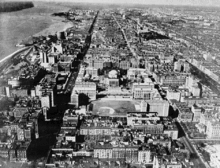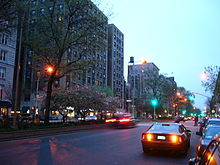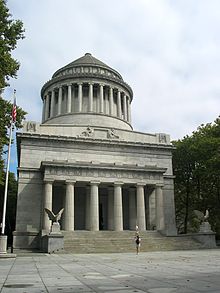- Morningside Heights, New York City
-
"Morningside Heights" redirects here. For the Toronto neighborhood, see Morningside Heights, Toronto. For other uses, see Morningside (disambiguation).
 Residential buildings on West 116th Street opposite Columbia University
Residential buildings on West 116th Street opposite Columbia University
Morningside Heights is a neighborhood of the Borough of Manhattan in New York City and is chiefly known as the home of institutions such as Columbia University, Teachers College, Barnard College, the Manhattan School of Music, Bank Street College of Education, the Cathedral of Saint John the Divine, the Riverside Church, Union Theological Seminary in the City of New York, Jewish Theological Seminary of America, Interchurch Center and St. Luke's Hospital.
Some residents consider Morningside Heights to be part of the Upper West Side.[1] However, many sources call it part of "Greater Harlem".[2][3] Many sources have the Upper West Side going no farther north than 110th street.[4][5][6] Morningside Heights is bounded by Saint Nicholas Avenue to the east[7], Harlem to the north, and Riverside Park to the west. The streets that form its boundaries are 110th Street on the south, Riverside Drive on the west, 125th Street on the north, and Morningside Drive to the east.[8] The main thoroughfare is Broadway. With the recent gentrification of Bloomingdale, the neighborhood immediately to the south of Morningside Heights, the southern boundary of this region is sometimes stretched to 106th Street and at times even 96th Street.
The neighborhood has also been referred to as a "college town" within New York City, the "Academic Acropolis", the "Acropolis of New York", and "Bloomingdale Village".[citation needed]
Contents
History
In the 17th century, the land that is now Morningside Heights was known as Vandewater's Heights, named for the landowner.[1]
On September 16, 1776, the Battle of Harlem Heights was fought in Morningside Heights, with the most intense fighting occurring in a sloping wheat field that is now the location of Barnard College. A plaque by the Columbia University gate on 117th Street and Broadway commemorates this battle.
Use of the name "Morningside Heights" for the neighborhood arose in the 1890s when development of the area commenced. Although the name "Bloomingdale" was used for the area about the Bloomingdale Insane Asylum (located at the present location of the main campus of Columbia University), other names such as "Morningside Hill" and "Riverside Heights" were used for the area and no single name was commonly used for the neighborhood as projects began to construct the university campus, and also the nearby Teachers College, the Cathedral of Saint John the Divine and St. Luke's Hospital. In time two names gained the most use; "Morningside Heights" was preferred by the two colleges while "Cathedral Heights" was preferred by St. John's and St. Luke's. After about 1898, Morningside Heights became the most generally accepted, although the diocese at St. John's continued to call the neighborhood Cathedral Heights well into the 20th century. The term "Morningside" came from the park on the east flank of the plateau, which was lit up by the rising sun and which was called "Morning Side Park" in 1870 when the city parks commissioner recommended a survey of the land.[8]
Many apartment buildings and rowhouses, amongst the first to use elevators in residential buildings, were built for New York's prosperous middle class in the first two decades of the twentieth century and most of these buildings are still extant.[8] By the mid-20th century the increasing prevalence of Single Room Occupancy (S.R.O.) hotels led to attendant socioeconomic problems and a decline in the neighborhood. Jane Jacobs The Death and Life of Great American Cities presented the neighborhood as a key example of the failure of the urban planning techniques of the era.
In 1947 David Rockefeller became involved in a major middle-income housing development when he was elected as chairman of Morningside Heights Inc. by fourteen major institutions that were based in the area, including Columbia University. In 1951 the organization developed Morningside Gardens, a six-building apartment complex to house middle-income families from all ethnic backgrounds.
The social problems in the area prompted Columbia to purchase much of the neighborhood's real estate, leading to accusations of forced eviction and gentrification. This process reached its nadir in 1968, when protests erupted in both the neighborhood and on Columbia's campus over the university's proposal to build a gym in Morningside Park. Residents alleged that the park's proposed separate entrance for Harlem residents on the lower level of the park was segregated, and that public park space was being annexed by a wealthy private institution. The university was eventually forced to abandon the plan, though it has still expanded its presence in the neighborhood markedly over the last few decades, and gentrification and urban renewal have proceeded apace. In January 2008 the university received approval from the City Council to expand significantly in nearby Manhattanville.
As the city grows and residents move in and out, neighborhood names change as well. Newcomers may consider Morningside Heights as an extension of the Upper West Side, though others hold onto the old name. In the last decade, some businesses in the area have started using the name SoHa (or "South of Harlem") to refer to the neighborhood. Examples of this include Max's SoHa restaurant and the former SoHa nightclub.
The neighborhood is part of the Fifteenth Congressional District of New York, which includes all of Upper Manhattan. Traditionally, Morningside Heights has been heavily Democratic.
The neighborhood's ZIP codes are 10025, 10026, and 10027.
Academic Acropolis
The label Academic Acropolis has been used to describe the area, since it sits on one of the highest natural points in Manhattan and contains numerous academic institutions. Much of the neighborhood is the campus of Columbia University, and the university also owns a large amount of the non-campus real estate. Other educational institutions in the neighborhood include Barnard College, Union Theological Seminary, New York Theological Seminary, Jewish Theological Seminary of America, Manhattan School of Music, Teachers College, Bank Street College of Education, St. Hilda's & St. Hugh's School, The School at Columbia University, Bank Street School for Children, The Cathedral School, New York, and for the younger residents, Columbia Greenhouse nursery school.[9]
NASA's Goddard Institute for Space Studies is also located in the neighborhood, directly above Tom's Restaurant (see below) in a building owned by Columbia University.
Sights
Non-academic landmarks in Morningside Heights include the Cathedral Church of Saint John the Divine, Grant's Tomb, Riverside Church, Interchurch Center, Corpus Christi Church (New York), where Thomas Merton was baptized, International House, and St. Luke's Hospital.
Restaurants
 West 121st Street seen from Amsterdam Avenue, Riverside Church in the background
West 121st Street seen from Amsterdam Avenue, Riverside Church in the background
A famous restaurant in Morningside Heights is Tom's Restaurant, on Broadway at W. 112th St. It was featured in a 1990s song, "Tom's Diner", by Suzanne Vega (an alumna of Barnard College). Later, exterior shots were used on the television sitcom Seinfeld as a stand-in for the daily hangout of the show's principal characters.
Community Food and Juice, an eco-conscious restaurant that serves American food and uses only cage-free eggs, organic flour, wild fish, and grass-fed beef is located at 2893 Broadway between West 112th and 113th Streets.[10][11][12][13]
The West End Bar was another famous local restaurant. It served especially as a meeting place for writers of the Beat Generation in the 1940s and 1950s, as well as one for student activists prior, during, and after the Columbia University protests of 1968. The bar also included the Jazz at The West End jazz room, which was run by jazz historian and DJ Phil Schaap for 17 years. In the late 2000s, it was absorbed into a Cuban restaurant chain, Havana Central, and became known as "Havana Central at the West End".
Notable residents
George Gershwin began composing his Rhapsody in Blue while living at 501 West 110th Street in Morningside Heights. Film director Cecil B. De Mille lived on 114th Street. F. Scott Fitzgerald lived at 200 Claremont Ave. while working in advertising and writing This Side of Paradise.[citation needed]
Comedian George Carlin grew up on 121st Street. In the comedy piece "White Harlem", which appears on his Occupation: Foole album, he said that younger residents would refer to the neighborhood as "White Harlem" as that name would likely be considered an intimidating locale by outsiders and give inhabitants thereof greater respect from outsiders.
Kathy Boudin of the Weather Underground lived on Morningside Drive until she was arrested by the FBI.[citation needed]
Longtime Morningside resident and neighborhood guide Jacob Appel has set many of his stories, including The Magic Laundry, in Morningside Heights.
Morningside Gardens residents
Main article: Morningside GardensSeveral famous neighborhood residents have lived in Morningside Gardens, an experimental co-op project built in 1957 between 123rd and LaSalle Streets, and Broadway and Amsterdam Avenues. Many professional African-Americans moved to Morningside Gardens to maintain roots with the black community of Harlem and to enjoy the benefits of a safe and integrated community. Among those were Thurgood Marshall, first black justice named to the Supreme Court. Singer/songwriter Fiona Apple and science fiction writer Samuel R. Delany also lived in the complex as youths.[citation needed]
Students
Main article: List of Columbia University peopleMany notable people have resided in the area while attending or teaching at Columbia University. Several, however, have had significant engagements with the neighborhood itself. While writing a master's thesis on William Blake at Columbia University, Thomas Merton attended Corpus Christi Church on West 121st St., where he formally converted to Catholicism. Barack Obama lived in a modest rented apartment at 142 West 109th St.[14][15]
See also
Notes
- ^ a b Jackson, Kenneth T., ed (1991). "Morningside Heights". Encyclopedia of New York. New Haven: Yale University Press. ISBN 0300055366.
- ^ http://www.nytimes.com/2010/01/06/nyregion/06harlem.html – "No Longer Majority Black, Harlem Is in Transition" – New York Times, January 5, 2010
- ^ http://www.nyctouristguide.com/morningside-heights-manhattan.asp – "Morningside Heights, Manhattan : NYC Tourist Guide"
- ^ http://www.nyc.gov/html/dcp/html/lucds/cdstart.shtml – "Community District Profiles" – New York City's The Department of City Planning
- ^ http://nymag.com/realestate/articles/neighborhoods/upperwest.htm – New York Magazine Neighborhood Profile: Upper West Side
- ^ http://www.nytimes.com/ref/realestate/nabe-morningside-heights.html – Morningside Heights, Manhattan, Real Estate Buying Guide (New York Times)
- ^ http://nymag.com/realestate/articles/neighborhoods/morningside.htm– "Neighborhood Profile" – New York City Real Estate
- ^ a b c Dolkart, Andrew S. (1998). Morningside Heights: A History of its Architecture and Development. New York: Columbia University Press. ISBN 0231078501.
- ^ Columbia Greenhouse, "one of America's oldest nursery schools"
- ^ Paul Adams (December 26, 2007). "Pillar of the Community". The New York Sun. http://www.nysun.com/food-drink/pillar-of-the-community/68527/. Retrieved May 12, 2011.
- ^ Adam Shepard (November 11, 2007). "The Dish: Five Guys, Lunetta, Community Food, ilili, Mason Dixon, Blue Ribbon Sushi". Eater NY. http://ny.eater.com/tags/adam-shepard. Retrieved May 12, 2011.
- ^ Moskin, Julia (January 30, 2008). "Dining Briefs; Community Food and Juice". The New York Times. http://www.nytimes.com/2008/01/30/dining/30briefs.html. Retrieved May 12, 2011.
- ^ Lane, Randall (December 27, 2007). "Mermaid Inn and Community Food & Juice". Time Out New York. http://newyork.timeout.com/restaurants-bars/18824/mermaid-inn-and-community-food-juice. Retrieved May 12, 2011.
- ^ Remnick, David (2010). The Bridge: The Life and Rise of Barack Obama. New York: Alfred A. Knopf. p. 113. ISBN 9781400043606.
- ^ Smith, Elizabeth A. (June 7, 2010). "Bragging Rights: President Obama Studied Here". The New York Times. http://www.nytimes.com/2010/06/13/realestate/13obama.html. Retrieved 2010-07-18.
References
- Hopper Striker Mott. The New York of Yesterday: A Descriptive Narrative of Old Bloomingdale. 1908.
- "Neighborhood Profile: Morningside Heights", New York Magazine Real Estate (online).
External links
Categories:- Neighborhoods in Manhattan
- Upper West Side
Wikimedia Foundation. 2010.






